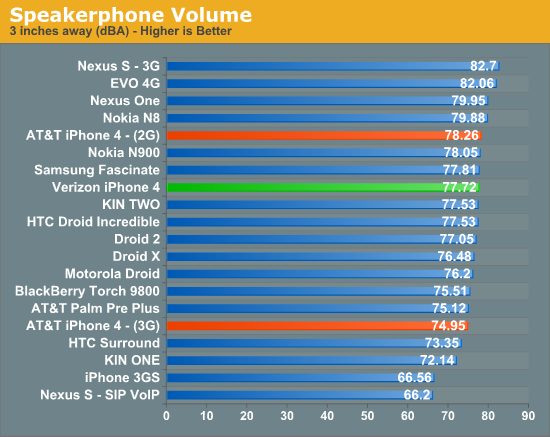Verizon iPhone 4: Thoroughly Reviewed
by Brian Klug on February 13, 2011 9:32 AM ESTVoice Quality
The other side of things is voice quality. Unfortunately we're still working on devising some objective call quality tests. On paper, the AT&T iPhone 4 supports wideband and narrowband adaptive multirate (NB-AMR and WB-AMR) voice codecs (vocoders) on UMTS. Remember that on UMTS (3G) voice and data are multiplexed and work at the same time. There's more bandwidth on that link, and as a result UMTS has a higher bitrate voice coder than GSM. That said AMR is variable bitrate (hence the name) and changes depending on link quality. UMTS has more dynamic range compared to GSM and CDMA2000 (EVRC) voice.
On the Verizon iPhone, EVRC is used as the vocoder. That's pretty much standard fare for CDMA2000 voice. The CDMA2000 spec has a number of different of vocoders, the most popular of which are 13k (for 13 kilobits/s), EVRC (which is 8, 4, or 0.8 kilobits/s), and somewhat newer EVRC-B. Way back in the day, it used to be almost trivially easy to change vocoders on Windows Mobile devices, and 13k sounded noticeably better than EVRC, which uses more compression. I've always found EVRC to be noticeably less appealing from an audio perspective than UMTS voice (WB-AMR), but roughly comparable to GSM voice. With EVRC there are audible compression artifacts at the start and end of spoken words, and more blocking and drop-out when 1x signal fades. In comparison, UMTS voice only drops out and degrades substantially right as you're at the bleeding edge of dropping the call entirely. EVRC has less dynamic range than UMTS, so it sounds subjectively louder - the tradeoff is that you lose high and low frequencies. Listening to "ess" sounds in words while on calls is always where the difference is noticeable.
The difference in dynamic range translates to the Verizon iPhone 4 being much louder, the same effect we discussed with the original iPhone 4 between calls on GSM and UMTS.

I set out to show the difference between GSM, UMTS, and CDMA2000 voice by calling the local ASOS weather station. I put together a video with the two iPhones calling the same number and running through the weather report one complete time. Unfortunately, the video camera I have doesn't quite do justice to how audibly different the three calls are, and I lack high quality audio recording equipment. We might follow up with different audio equipment soon, however.
The bigger difference between the two is reliability. Because voice and SMS goes over 1xRTT on Verizon, usually when you can't transact data, calls still work. With the AT&T iPhone 4, when saturation on UMTS happens, you won't be able to call or transact data unless you manually toggle 2G. The result is some built-in robustness for voice on Verizon purely because of that voice/data segregation. In addition, Verizon often puts 1x voice on 800 MHz spectrum and EVDO on 1900 MHz PCS where posisble, so voice coverage tends to work even in places data doesn't necessarily.
In use, the Verizon iPhone 4 will briefly show the "o" symbol for 1xRTT data and then quickly re-acquire EVDO and show "3G." After a call you can see this behavior and the quick re-acquisition of EVDO.
It'd be pure speculation at this point to predict how well Verizon's network will cope with more and more iPhone users. That said, having the data-hungry iPhone on two major carriers definitely will help spread the load as users switch depending on which is better in their market.










35 Comments
View All Comments
pshen7 - Tuesday, February 22, 2011 - link
Now that the iPhone will be part of Verizon, will there be less dropped calls? I don't know if the dropped calls were because of ATT network or the high volume of iPhone usage. If its the latter than the dropped calls will still continue. I am switching my service to Verizon so i guess I will find out.Peter Shen, founder Koowie.com
vks - Tuesday, February 22, 2011 - link
Please leave a comment at below link:vs-technologyhub.blogspot.com/2011/02/best-10-iphone-apps.html
deepakjulien - Monday, March 21, 2011 - link
Verizon getting the iPhone would be a great news, but I feel upgrading at this point of time is not reasonable beacuse of these reasons listed here - http://deepakjulien.com/why-you-should-not-buy-the...deepakjulien - Monday, March 21, 2011 - link
Here is the network coverage and data plan review of the AT&T 3G and Verizon 3G networks and also few points one should know even before considering switching from GSM to CDMA network technologies - http://deepakjulien.com/verizon-vs-att-iphone-4.ht...George Kanyowile - Monday, September 3, 2012 - link
My iPhone 4 reads Designed by Apple in Califomia Assembled in TaiWan . CALIFOMIA + TaiWan ? Please help . Is this an original ? The serial number checked out when I followed one link , however.